Oil Silo Home by PINKCLOUD. DK
By Bustler Editors|
Wednesday, Feb 15, 2012
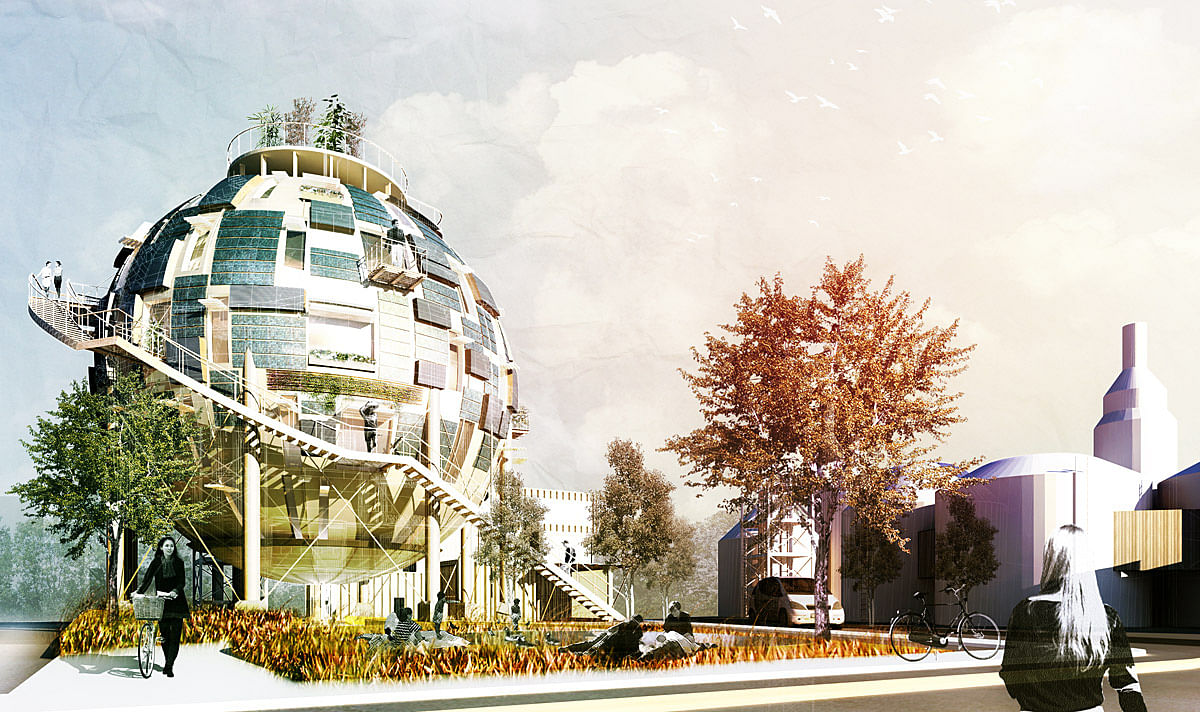
Related
Just a few days ago, we published the winning entry of the 2011 DOW Design to Zero competition. Here is now also the third prize winner, the entry Oil Silo Home, by architects Leon Lai and Eric Tan of pinkcloud.dk. The proposal recycles existing oil silos by transforming them into affordable housing for families worldwide.
Project Description from the Architects:
PEAK OIL IS NEAR…
An oil silo, or LPG Vessel, is a storage container for compressed liquefied petroleum gas. Oil silos are fully pressurized, waterproof, and built to meet industrial standards. There are approximately 49,000 oil silos in over 660 oil refineries worldwide!
As the human population increases at an exponential rate, oil discovery is decreasing at an exponential rate. Natural gas is becoming scarce and oil silos are now becoming abandoned as storage containers. As Earth rapidly approaches Peak Oil, non-renewable fossil fuel resources are diminishing fast. Soon humans can no longer depend on natural gas as an energy source. At this point, humans cannot use the existing 49,000 oil silos as fuel storage containers. Oil Silos will all be emptied and abandoned.
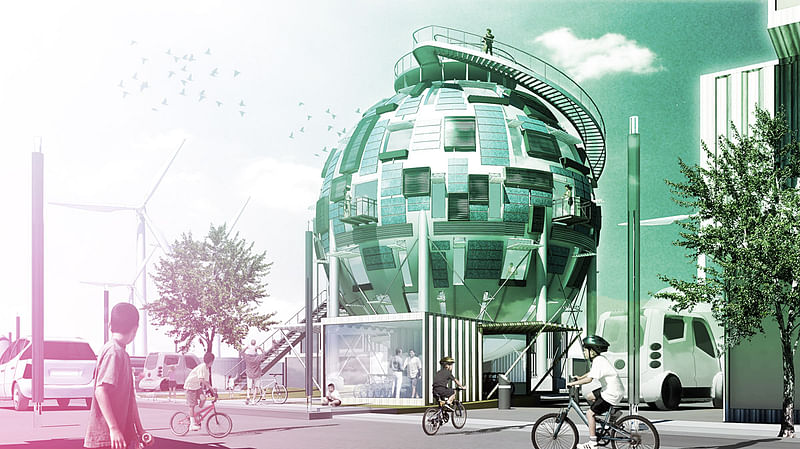
OIL SILO HOME
Ecological Sustainability + Economical Sustainability = Revitalization!
The Oil Silo Home recycles existing empty oil silos by transforming them into affordable housing for families worldwide. It’s a 100% self-supporting housing solution for the post-oil world. As an adaptive-reuse design, the Oil Silo Home incurs extraordinarily low costs. It’s highly structurally stable, efficient to assemble and disassemble, and has the capacity for pre-fabrication and mass production. Waste and embodied energy are dramatically reduced by the Oil Silo Home. By recycling existing abandoned silos for housing, we can revitalize former oil refineries and industrial zones into healthy, thriving communities. As a carbon-positive design, the Oil Silo Home can actually contribute energy back into the grid.
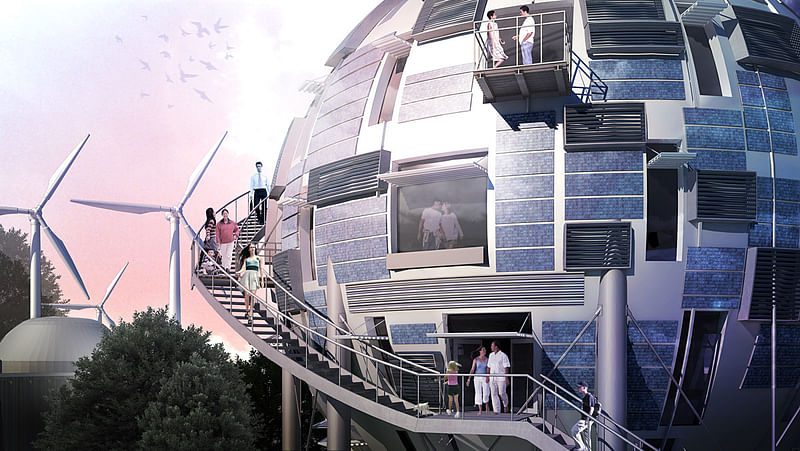
SPHERICAL ADVANTAGE
The spherical geometry of oil silos provides optimal orientation for harvesting sunlight year-round. Simultaneously, surface exposure is maximized for the installation of solar devices. Sunlight is collected by photovoltaic panels and solar hot water heaters installed along the silo periphery. The oil silo’s spherical shape resists the negative effects of global warming with strong structural rigidity, flexible suspension, waterproof shell, and aerodynamic geometry which effectively decreases uplift due to pressure from airflows. Energy efficiency is a priority; the spherical silo provides efficient circular passive ventilation and even heat distribution.

(RE)CONSTRUCTION
Contaminated oil silos are first detoxified with In Situ oil bioremediation. In this process, soil microbes which eat harmful pollutants clean up toxic chemicals, leaving only harmless byproducts such as CO2 gas. Existing oil silos are then retrofitted on-site. Large-scale components for the Oil Silo Home are pre-fabricated offsite. Modular assembly reduces construction cost and manufacturing time, thereby enabling consistent quality and efficient mass production of silo home components.

BEYOND CARBON NEUTRAL
The Oil Silo Home is designed to generate energy while simultaneously reducing energy use. Our design comprises an integrated set of passive sustainable installations augmented by the silo’s inherent spherical shape. The Oil Silo Home exceeds a carbon-neutral classification and ultimately strives to achieve a carbon-positive rating, thereby benefitting the environment by producing more energy than it consumes. The 700 existing oil refineries have great potential for redevelopment. Refineries can actually be converted into thriving green communities which generate clean energy. Oil Silo Home communities have the capacity to effectively transform existing refineries into mega solar plants which produce clean energy.

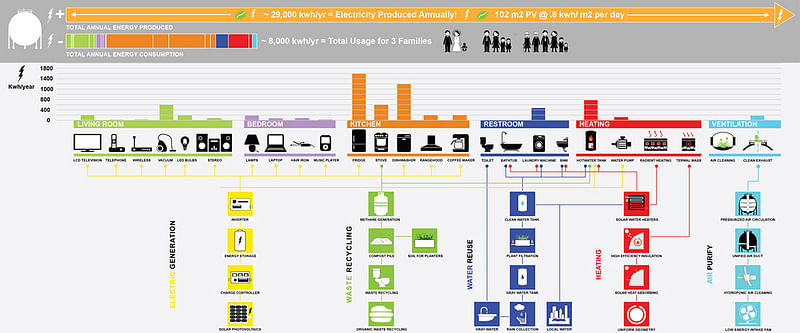
1 SILO HOME/3 UNITS /12 RESIDENTS
The Oil Silo Home is divided into three separate units accessible by a central pneumatic elevator and exterior walkway leading to the roof garden. Living and sleeping spaces circumnavigate the circular plan to provide copious natural lighting. The multi-generational home encompasses one full floor plate while the smaller two and four-person family homes are divided into two levels. All units feature large openings equipped with prefabricated balcony units for generous open-air ventilation. Interaction between neighbors is facilitated by situating the main entrance of each unit along the exterior walkway, thereby maintaining communal connection while providing private terrace space for each family.

UNIT 1
2-Person Young Family
Area: approx. 90 m2
UNIT 2
4-Person Nuclear Family
Area: approx. 180 m2
UNIT 3
6-Person Multi-Generational Family
Area: approx. 225 m2
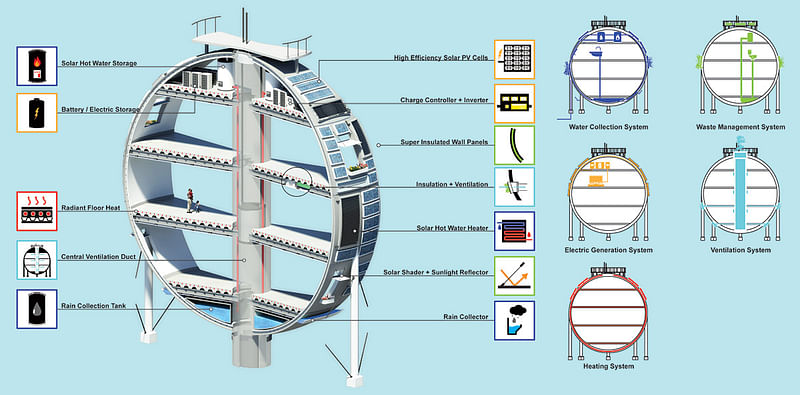
SHARED RESOURCES
The Silo Home Community is interconnected with a shared resource infrastructure. While resources are produced by individual mechanisms throughout the community, all resources are pooled and shared to maintain sufficient levels of energy, water, and clean air. This unified system of resource allocation meets the needs of all citizens of the community while conserving resources and minimizing waste. For example, windmill-derived energy and surplus energy generated by solar PV cells in silo homes are transferred to electric charging stations and community buildings throughout the local district.
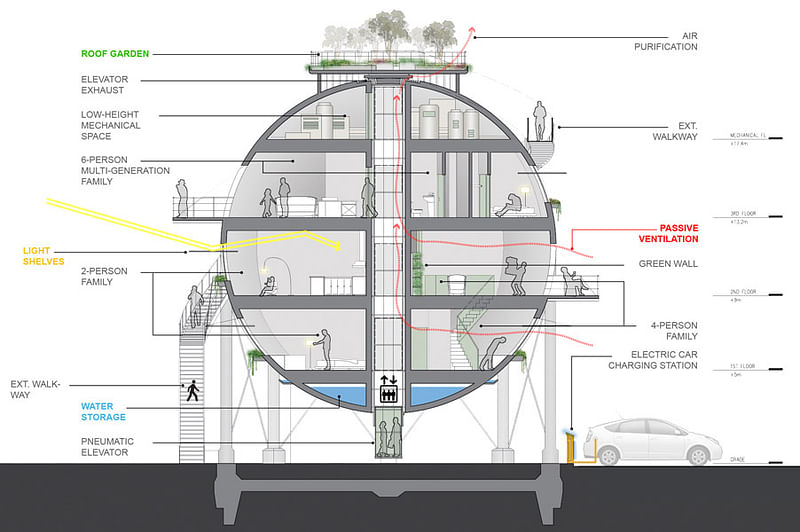
COST ANALYSIS
The pre-existence of almost 50,000 oil silos worldwide eliminates the standard costs of new construction, relying solely on the costs of converting existing silos for human habitation. Oil silos are built to extremely high industrial standards, ensuring a high degree of structural integrity without extra costs. Modular retrofitting allows for easy maintenance and decreases costs incurred by damages. Each Oil Silo Home has a zero net-energy cost with a potential government payback by transferring extra energy back into the city grid. Renewable energy is the primary power source for the Oil Silo Home, virtually eliminating all energy costs and creating an affordable housing solution for many middle-class American families.
Read more about the proposal at le-pc.org.




Share
0 Comments
Comment as :